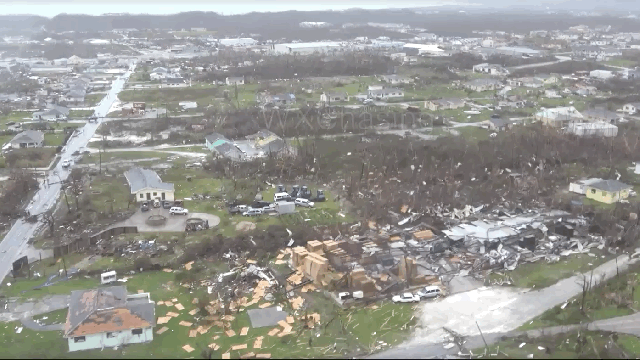Even before landfall, it was pretty clear Grand Bahama and the Abaco Islands would never be the same after Hurricane Dorian. Now, after 36 hours of pummelling winds and waves from the Category 5 hurricane, the world is getting its first glimpse at what that devastating transformation looks like.
Aerial footage has revealed shipping containers ripped open like tin cans, houses scattered and torn apart, and boats hundreds of feet inland from the nearest marinas. The aerial footage was shot by storm chasers who flew over Abaco, the first island to get struck by Hurricane Dorian. WXChasing, the storm chasers who shot the footage, reported that conditions were rough and that there were still hurricane-force winds (winds greater than 119km/h) blowing when they took off.
Aerial photos posted by local site Our News and shared by an assistant news editor at the Nassau Guardian revealed similar scenes of chaos and destruction.
No footage has yet emerged from Grand Bahama, which Dorian tracked over for an astounding 36 hours as forward movement of the storm ground to a halt. But if the Abaco images and footage are any indication, the damage there is likely to be similarly catastrophic.
Our first images of Abaco from air. pic.twitter.com/rPmXuKDrSD
— Travis C-Carroll (@TravisCC) September 3, 2019
Hurricane Dorian made landfall as the strongest hurricane in history to strike the Bahamas. Its winds peaked at 298km/h, which put Dorian in a four-way tie for the second-strongest hurricane ever recorded in the Atlantic. Only 1980’s Hurricane Allen — which had sustained winds that topped out at 306km/h — was stronger.
That puts it well beyond its Category 5 ranking in some ways. Those rankings come courtesy of the Saffir Simpson Scale, which delineates categories based on structural damage different wind speeds will cause. Here’s how the scale describes a Category 5 hurricane:
“Catastrophic damage will occur: A high percentage of framed homes will be destroyed, with total roof failure and wall collapse. Fallen trees and power poles will isolate residential areas. Power outages will last for weeks to possibly months. Most of the area will be uninhabitable for weeks or months.”
In Dorian’s case, all those things appear to be coming to bear. The Red Cross estimates that an astounding 99 per cent of people on the islands will need emergency assistance, and at least 13,000 houses — 45 per cent of the islands’ housing stock — have been damaged or destroyed.
Though there are only five reported deaths, that number will almost surely rise as rescue crews begin to make their way across the islands. If you’d like to help with recovery efforts, Lifehacker has a helpful guide for how to direct your resources.
